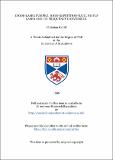Files in this item
Diode-laser pumped, high-repetition-rate, Nd:YLF laser and its frequency conversion
Item metadata
| dc.contributor.advisor | Dunn, Malcolm H. | |
| dc.contributor.author | Rahlff, Christian | |
| dc.coverage.spatial | 263,[6]p. of plates. | en_US |
| dc.date.accessioned | 2018-06-06T10:48:58Z | |
| dc.date.available | 2018-06-06T10:48:58Z | |
| dc.date.issued | 1996-07 | |
| dc.identifier.uri | https://hdl.handle.net/10023/13763 | |
| dc.description.abstract | This thesis describes the development of a continuous-wave (cw), diode pumped, repetitively Q-switched Nd:YLF laser, and its application as a pump source for non-linear optical frequency converters and optical parametric oscillators (OPO's), with typical pulse widths of several tens of nanoseconds and repetition rates in the kHz region. At the core of this thesis is the proposal and realisation of a novel rhombic Nd:YLF slab geometry, which is pumped by two 20W cw AlGaAs diode arrays, each focused by means of 3 lenses into a folded resonator path. The novelty of this adaptation is that it uses Yttrium Lithium Fluoride (YLF), known for its comparatively low tensile strength, as the Neodymium host crystal, by addressing and solving the thermal stress fracture problem in YLF for pump powers up to 20W per surface in an end-pumped configuration. With the excellent beam quality, high average output power and short pulses achieved, Nd:YLF has been established as an excellent material for high density, diode pumped, Q-switched lasers at 1047nm. With identical slabs coated for 1321nm operation also available, the performance and laser parameters such as crossection, linewidth and thermal lensing for these two transitions were compared. The pronounced change in the thermal lensing of the 1321nm transition led to an investigation of excited state upconversion (ESA) in Nd:YLF at 1047 and 1321nm under cw and Q-switched operation. The excellent access to the pumped volume made not only a time dependent spectral analysis of the visible and near UV fluorescence bands possible, but also permitted a spatial analysis of the different up-conversion areas. This pump density and laser transition dependent loss mechanism has implications on the end-effect governed lensing, upper state lifetime and Q-switched pulse form. The low threshold, high repetition rate conversion schemes realised during this thesis expanded the spectral cover of the 1mum pump laser from the near UV (349nm) at one end of the spectrum over the green (523.5nm) and 1.5mum region up to the near infrared at 3.445mum. The progress in this area lies not in the well known phase match configuration of the materials used such as KTP, KTA and LBO, but in the adaptation of these nonlinear converters and non-critically phase matched (NCPM) OPO's to achieve high conversion efficiencies at low pulse energies (typically less than 1mJ, 40kW). With average output powers in the green of 3W (~60% conversion from the IR at 6kHz repetition rate), 750mW in the UV, IW at 1.54mum and 280mW at 3.44mum it has been demonstrated that the high average output power of the repetitively Q-switched system can be preserved in the up- and down-converted radiation. | en_US |
| dc.language.iso | en | en_US |
| dc.publisher | University of St Andrews | |
| dc.subject.lcc | TK7871.3R2 | |
| dc.subject.lcsh | Lasers | |
| dc.title | Diode-laser pumped, high-repetition-rate, Nd:YLF laser and its frequency conversion | en_US |
| dc.type | Thesis | en_US |
| dc.type.qualificationlevel | Doctoral | en_US |
| dc.type.qualificationname | PhD Doctor of Philosophy | en_US |
| dc.publisher.institution | The University of St Andrews | en_US |
This item appears in the following Collection(s)
Items in the St Andrews Research Repository are protected by copyright, with all rights reserved, unless otherwise indicated.

